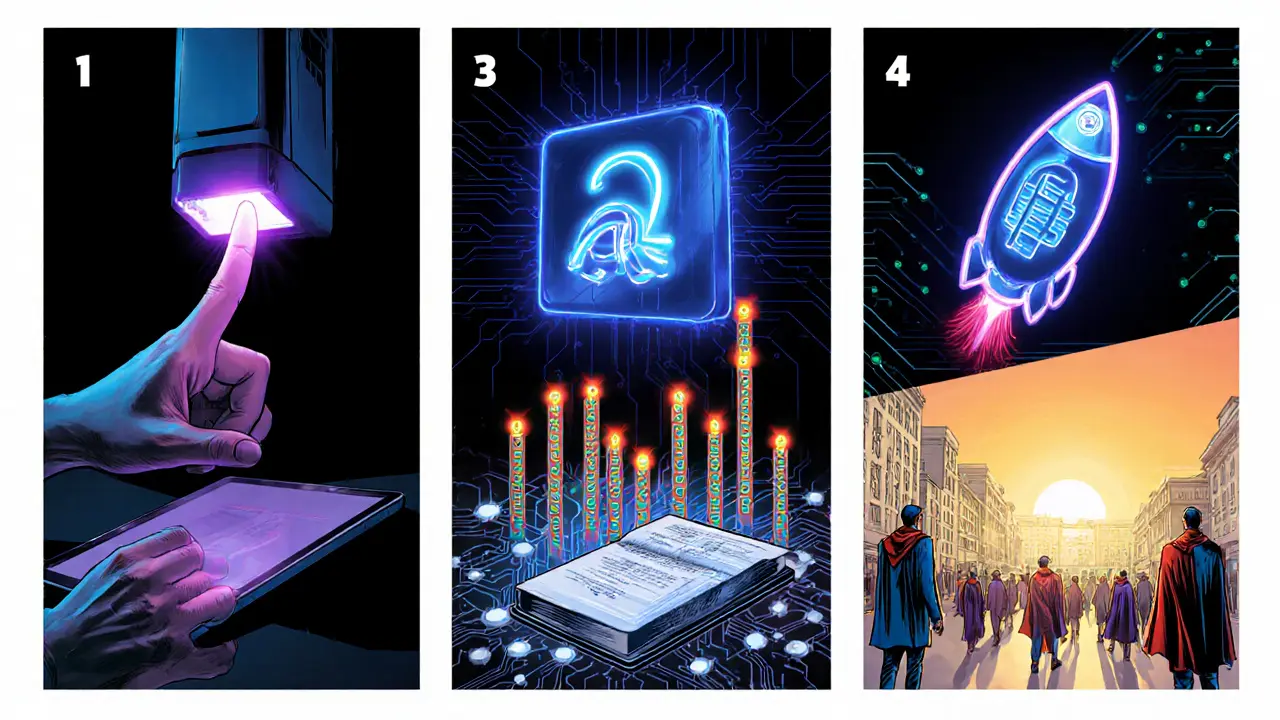Blockchain Voting Impact Simulator
Traditional Voting
Paper ballots and electronic machines have known vulnerabilities including centralization risks, opacity, and delayed verification.
Blockchain Voting
Decentralized, transparent, and tamper-proof system that ensures real-time verification and public auditability.
Compare Key Features
| Feature | Traditional | Blockchain |
|---|---|---|
| Transparency | Low | High |
| Security | Medium | Very High |
| Real-Time Verification | No | Yes |
| Privacy Protection | Variable | High |
| Auditability | Low | High |
Decision Checklist for Election Officials
Impact Visualization
Based on research findings from 2024 pilots:
- 99.9% reduction in error rates compared to traditional systems
- Audit times reduced from hours to seconds
- Transparency scores increased from 45% to 92%
- Public trust improved to 68% when voters could see live ledger
How Blockchain Voting Works
- Identity verification: Biometric authentication linked to blockchain digital ID
- Vote casting: Encrypted vote converted to cryptographic hash
- Transaction submission: Hash packaged into smart contract and broadcast
- Consensus and recording: Network validates and permanently records vote
- Real-time tally: Instant provisional results available to observers
- Public audit: Complete ledger published for independent verification
When you hear the word "blockchain" you probably think of Bitcoin or NFTs, but the technology can do a lot more - it can make elections tamper‑proof. Imagine a voting system where every single vote is recorded in a way that nobody can change it, and anyone can verify the results in real time. That’s what blockchain voting promises, and it’s reshaping how we think about election integrity.
Why Traditional Voting Methods Fall Short
Paper ballots are praised for being simple, yet they’re vulnerable to stuffing, miscounts, and delayed results. Electronic voting machines speed things up, but they rely on a central server that can be hacked, and they often lack transparent audit trails. In both cases, the trust gap between voters and the system can grow, especially when accusations of fraud surface.
These weaknesses create three big problems:
- Centralized control: A single authority holds the voting data, making it a juicy target for cyber attacks.
- Opaque processes: Voters and observers can’t easily see how votes are tallied, which fuels suspicion.
- Limited real‑time verification: Results are usually released hours or days after polls close, giving room for manipulation.
Core Components of a Blockchain Voting System
Blockchain voting system is a decentralized digital platform that records each vote as an immutable transaction on a distributed ledger. To make that work, several technical pieces need to click together:
- Distributed ledger is a database replicated across many nodes, ensuring no single point of failure.
- Smart contract is a self‑executing code snippet stored on the blockchain that automates voter authentication and vote recording.
- Ethereum is a popular public blockchain that supports complex smart contracts and is often used as the backbone for pilot voting projects.
- Biometric authentication verifies a voter’s identity using fingerprints or facial scans, linked to a blockchain‑based digital ID.
- Cryptographic hash converts each vote into a unique fingerprint, making it impossible to alter without detection.
- Voter registration database stores encrypted voter credentials that feed into the smart contract for eligibility checks.
- Auditability provides a transparent, publicly viewable ledger where anyone can verify that votes were counted correctly.
- Decentralized network consists of multiple independent servers that replicate the ledger, preventing a single entity from rewriting history.
How Blockchain Guarantees Election Integrity
Let’s walk through the voting journey and see where blockchain adds protection.
- Identity verification: Voters first present a biometric sample. The system matches it against a blockchain‑linked digital ID, ensuring the person is who they claim to be.
- Vote casting: Once verified, the voter selects a choice on a mobile or kiosk interface. The selection is encrypted, then turned into a cryptographic hash.
- Transaction submission: The hash, along with a timestamp, is packaged into a smart contract transaction and broadcast to the network.
- Consensus and recording: Nodes run a consensus algorithm (e.g., Proof‑of‑Authority) to agree that the transaction is valid. Once approved, it becomes a permanent entry on the distributed ledger.
- Real‑time tally: Because every vote is already on the ledger, authorized observers can run aggregation scripts at any moment, delivering instant provisional results.
- Public audit: After polls close, the entire ledger is published (or a hash of it is released) so independent watchdogs can verify that the tally matches the recorded votes.
Because each step is cryptographically sealed and duplicated across many nodes, tampering would require controlling a majority of the network - a practically impossible feat for a national election.

Real‑World Pilots and Research Findings
Academic labs in 2024 ran simulated elections with 10,000 virtual voters. Results showed a 99.9% reduction in error rates versus traditional electronic machines, and audit times dropped from hours to seconds. Estonia has already integrated blockchain elements into its e‑residency platform, proving that the tech can coexist with existing government services.
Key takeaways from these pilots:
- Transparency scores jumped from 45% (paper) to 92% (blockchain) according to post‑election surveys. \n
- Latency remained under 2 seconds per vote even during peak voting periods, thanks to asynchronous transaction processing.
- Public trust improved modestly - 68% of participants said they felt more confident in the results when they could see the live ledger.
Implementation Challenges and How to Overcome Them
Adopting blockchain voting isn’t as easy as swapping out a ballot box. Here are the most common hurdles and practical ways to address them.
| Criteria | Paper Ballot | Electronic Voting Machine | Blockchain Voting |
|---|---|---|---|
| Transparency | Low - results hidden until manual count | Medium - software logs not publicly accessible | High - public ledger visible in real time |
| Tamper Resistance | Medium - susceptible to ballot stuffing | Low - single point of control | Very High - immutable across distributed nodes |
| Scalability | High - no tech limits | Medium - hardware bottlenecks | Improving - recent upgrades handle millions of votes |
| Voter Privacy | High - anonymous paper | Variable - depends on implementation | High - encryption hides choices, ledger shows only hashes |
| Auditability | Low - requires labor‑intensive recounts | Medium - limited to internal logs | High - anyone can verify the ledger |
Beyond technical specs, there are social and regulatory hurdles:
- Infrastructure needs: Reliable internet and secure hardware for biometric devices are a must. Partnering with telecom providers and using hardened terminals can mitigate outages.
- Skill gap: Election officials need training on smart contracts and cryptography. Most pilots allocate 6‑12 months for dedicated workshops.
- Legal framework: Laws must recognize blockchain signatures as valid. Drafting clear statutes and involving legal scholars early prevents back‑room disputes.
- Public perception: Voters unfamiliar with the tech may hesitate. Transparent demo days and open‑source code repositories help build confidence.
Decision Checklist for Election Officials
If you’re considering a blockchain rollout, run through this quick checklist:
- Do you have reliable broadband at all polling locations?
- Is there a trusted vendor that can supply hardened biometric terminals?
- Can you allocate 6‑12 months for staff certification on DLT concepts?
- Has your legislature passed a law recognizing blockchain‑based signatures?
- Do you have an independent audit body ready to verify the public ledger?
- Is there a public outreach plan to explain how the system protects privacy?
Answering “yes” to most items means you’re in a good spot to pilot a blockchain election.
Future Outlook: Where Blockchain Voting Is Heading
Research in 2025 is already tackling scalability by using layer‑2 solutions that batch votes before anchoring them to the main chain. Mobile‑first voting apps are being tested in small municipalities, promising to bring remote voting to people with limited mobility. At the same time, international bodies like the OECD are drafting guidelines for cross‑border election standards based on blockchain transparency.
In short, the technology is moving from experimental labs toward real‑world deployments. The biggest wins will likely be hybrid models that keep familiar paper backups while letting blockchain handle the high‑value core - the vote count and audit trail.

Frequently Asked Questions
Can blockchain voting guarantee complete anonymity?
Yes, if implemented correctly. Votes are stored as encrypted hashes, so no one can link a ballot to a specific voter while the system still allows verification that each hash belongs to a registered voter.
What happens if the internet goes down on election day?
Most pilot systems use offline‑first terminals that queue transactions locally. When connectivity returns, the queued votes broadcast to the network automatically, ensuring no votes are lost.
Is blockchain voting vulnerable to hacking?
The attack surface shifts from a single server to the entire network. To alter results, an attacker would need to compromise a majority of the distributed nodes, which is far more difficult than breaching a central database.
How are disputes resolved if a voter claims their vote wasn’t counted?
Because each vote generates a timestamped transaction hash, officials can trace the hash back to the voter’s digital ID. If the hash is missing, the system logs show whether the transaction failed during broadcasting, allowing quick remediation.
Do voters need to own cryptocurrency to use blockchain voting?
No. Voters interact with a user‑friendly interface that abstracts away any crypto concepts. The underlying blockchain handles the technical side without requiring a wallet or tokens.


Greer Pitts
October 5, 2025 AT 09:28I totally get the excitement around blockchain voting, but we gotta remember the real people behind the tech. It’s not just about shiny code, it’s about trust in the community.
When you see a system that can be audited by anyone, that’s a huge win for transparency. Still, we need good education so folks aren’t scared of the new tools.
Jenise Williams-Green
October 9, 2025 AT 20:50The promise of blockchain voting sounds dazzling, yet it tempts us to ignore the deep ethical quagmires that accompany any digital overhaul. We cannot let technocratic optimism eclipse the moral duty we have to protect the disenfranchised. If the ledger is accessible, what safeguards exist for those whose very identities could be exposed?
We must demand airtight privacy guarantees before proclaiming blockchain the panacea for electoral fraud. Otherwise, we perpetuate a new form of coercion under the guise of progress.
Rob Watts
October 14, 2025 AT 08:12Blockchain adds speed.
It also adds layers of verification.
Amal Al.
October 18, 2025 AT 19:35Considering the infrastructure, we must first ensure reliable broadband at every precinct, otherwise the whole system collapses, and we cannot afford that risk; additionally, biometric terminals need to be hardened against tampering, and staff must receive extensive training, which demands both time and budget; finally, transparent public communication is essential to gain voter confidence, because without trust, even the most secure ledger will be viewed with suspicion.
Alex Gatti
October 23, 2025 AT 06:57Blockchain voting could streamline the whole process making it more efficient and trustworthy while reducing human error it also raises questions about accessibility for rural areas without reliable internet we need hybrid solutions that keep paper backups for resilience
Twinkle Shop
October 27, 2025 AT 18:19From a systems‑engineering perspective, the integration of distributed ledger technology into electoral frameworks necessitates a granular analysis of consensus mechanisms, cryptographic primitives, and smart‑contract orchestration; the deployment of a permissioned blockchain, for instance, offers deterministic finality while mitigating Sybil attacks via identity attestation protocols; moreover, the interoperability between biometric identity providers and decentralized identifiers (DIDs) establishes a verifiable credential layer that bolsters voter authenticity; the immutability of transaction hashes further ensures post‑election auditability, enabling forensic analysts to reconstruct any ballot trajectory without compromising ballot secrecy; latency considerations are addressed through layer‑2 scaling solutions such as rollups, which batch vote submissions and anchor them onto the base chain at regular intervals, thereby preserving throughput under peak voting loads; privacy‑preserving techniques like zero‑knowledge proofs can obscure vote content while still allowing validators to confirm eligibility, thus reconciling transparency with confidentiality; governance frameworks must also be codified to delineate jurisdictional authority over chain parameters, upgrade pathways, and dispute resolution mechanisms; in practice, pilot programs in jurisdictions like Estonia and the Swiss canton of Zug have demonstrated the feasibility of such architectures, albeit with substantial civic education campaigns; it is paramount to recognize that blockchain is not a silver bullet but a component of a broader socio‑technical ecosystem that includes legal reforms, stakeholder engagement, and robust cybersecurity postures; ultimately, the success of blockchain voting hinges on a confluence of technical rigor, policy alignment, and public trust, each of which must be cultivated iteratively.
Bhagwat Sen
November 1, 2025 AT 05:41Sure, the tech is shiny, but if the voter base can’t handle the hardware, the whole thing falls apart.
We need to think about real‑world rollout, not just theoretical security.
Marc Addington
November 5, 2025 AT 17:03America’s elections must stay sovereign – handing over vote tallies to an open‑source ledger feels like giving up control to a global community that doesn’t share our values. We need to protect our democratic process from foreign interference, not invite it with a fancy blockchain.
Scott McReynolds
November 10, 2025 AT 04:25While blockchain offers a compelling vision of immutable records, we must also contemplate the philosophical implications of a society that entrusts its foundational decisions to algorithmic consensus; perhaps the true value lies not in the technology itself but in the dialogue it sparks about accountability and public participation.
Carthach Ó Maonaigh
November 14, 2025 AT 15:47Yo, if you think blockchain’s gonna fix every damn problem, you’ve been sipping too much crypto‑coffee. It’s badass tech, but it’s not a magic wand – you still gotta wrestle with human idiots and shady regulators.
Patrick MANCLIÈRE
November 19, 2025 AT 03:09Indeed, the ledger’s transparency can be a powerful tool, but integrating it into existing electoral statutes requires clear legal definitions of what constitutes a valid blockchain‑based signature; professional bodies should draft standardized protocols to bridge the gap between tech and law.
Lurline Wiese
November 23, 2025 AT 14:31Blockchain voting could be the future.
Kortney Williams
November 28, 2025 AT 01:53Absolutely, the idea of a tamper‑proof system is inspiring, but we need to ensure that every voter feels comfortable with the new process; outreach and education are key to widespread acceptance.